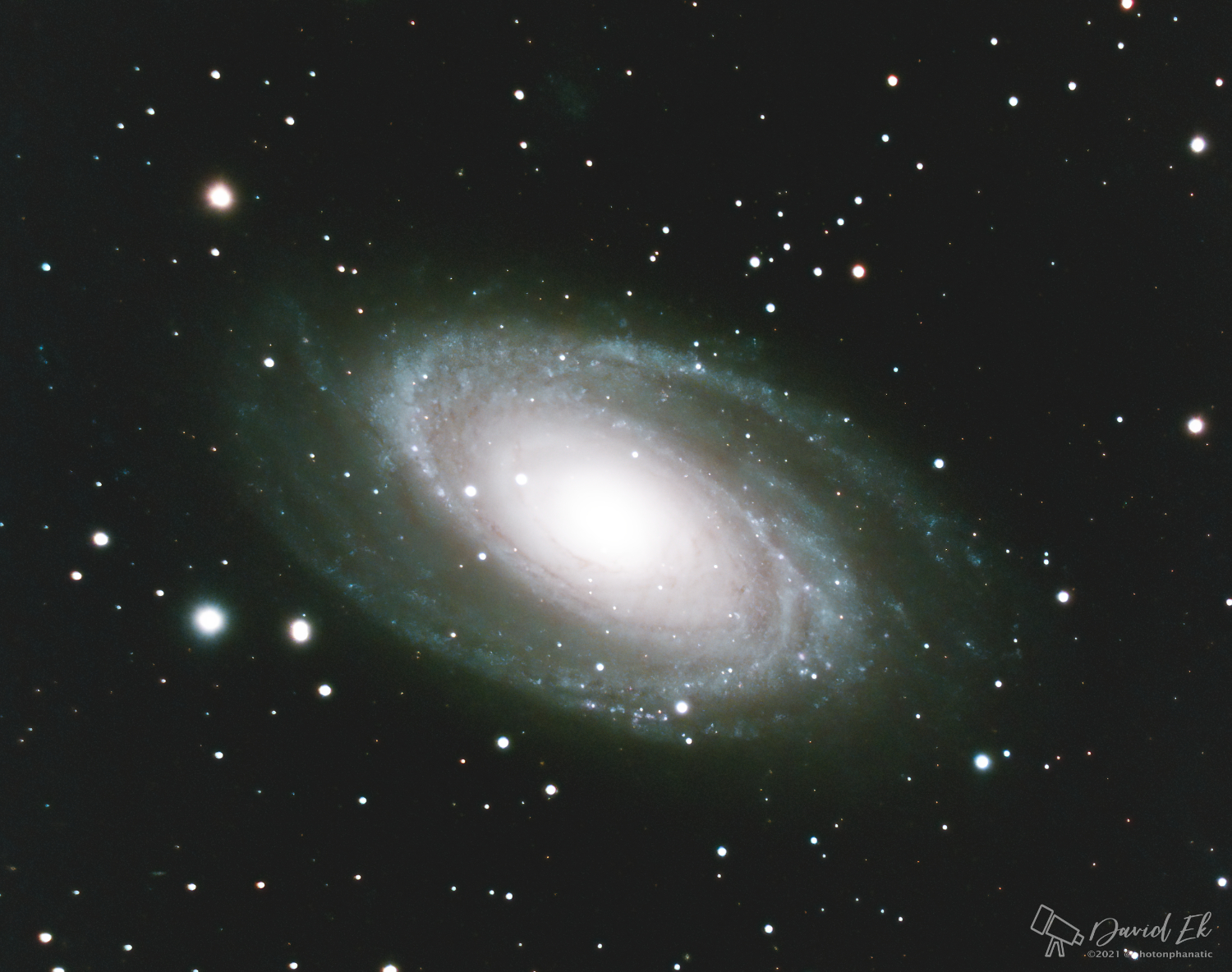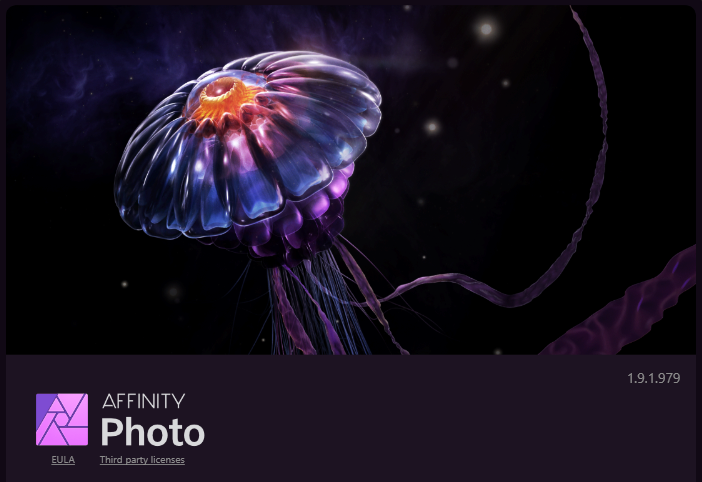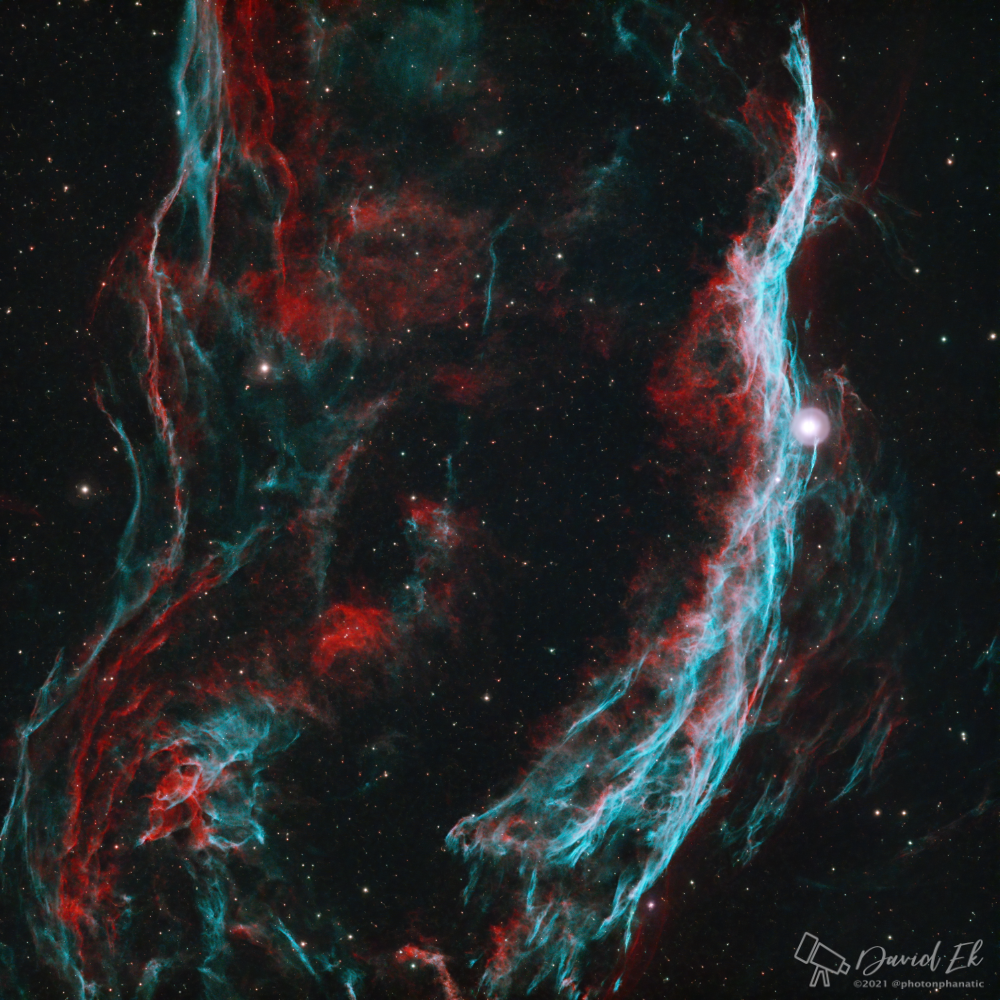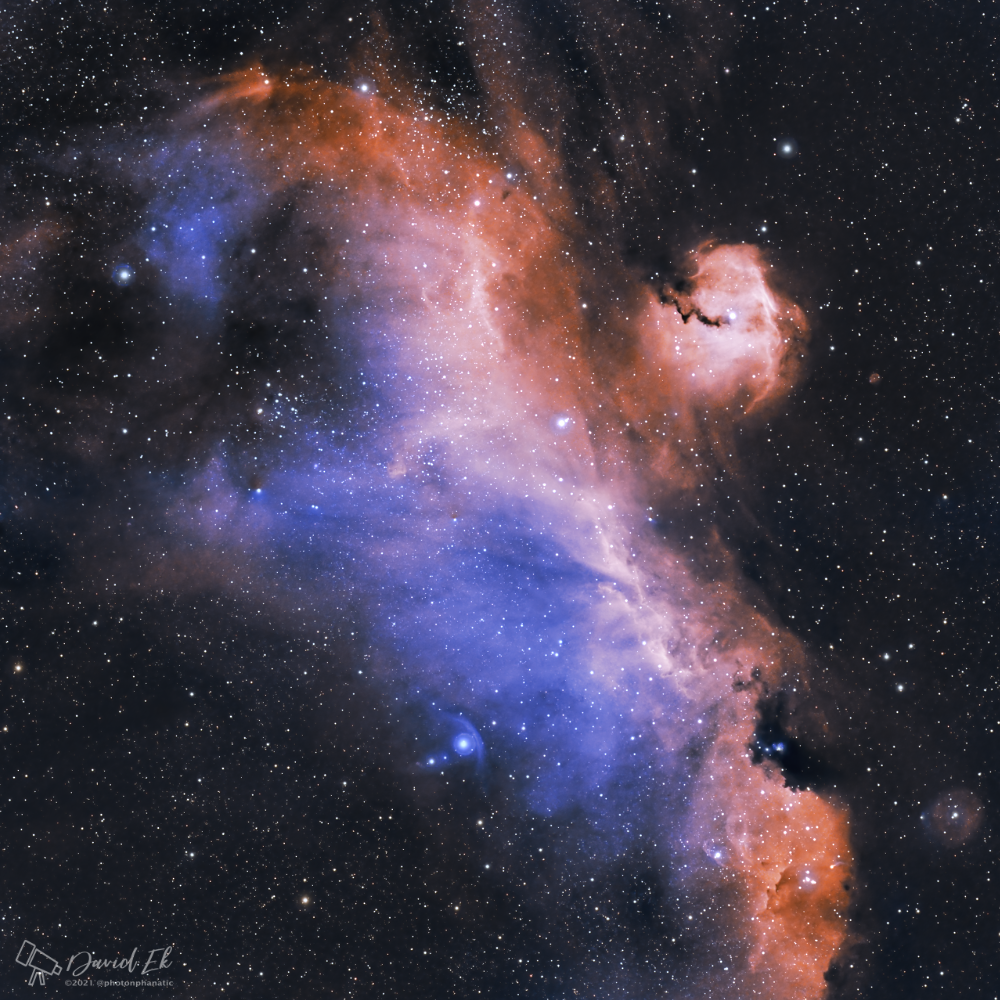After shooting the East Veil Nebula a month or two ago, I wanted to come back to more of the Veil Nebula complex in Cygnus and shoot other parts of it. I love the colors and the wispiness of this nebula, and my narrow-band filter does a fabulous job on it, IMHO. By the time I got back to this target, it was high enough in the sky at dusk that I could only shoot it for about four hours a night. I managed to capture a total of seven hours on this target over the course of two nights. This is once again a narrow-band image using the Optolong L-Extreme dual-band filter, shooting with a ZWO ASI533MC Pro cooled color camera through a Sky-Watcher Esprit 100 f/5.5 apo refractor on an iOptron GEM45 mount. Processed using PixInsight, Affinity Photo, and Denoise AI.
The Bubble Nebula
Clear skies and a new moon will find me capturing more photons, and a few days ago I was able to collect 8 hours worth of light from the Bubble Nebula (NGC 7635), along with the Cassiopeia Salt and Pepper Cluster (M52). This is once again a narrow-band image using the Optolong L-Extreme dual-band filter, shooting with a ZWO ASI533MC Pro cooled color camera through a Sky-Watcher Esprit 100 f/5.5 apo refractor on an iOptron GEM45 mount. Processed using PixInsight, Affinity Photo, and Denoise AI.
It’s pretty rare, it seems, that I can actually get 8 hours of good data in a single evening. Only a couple of the subs had satellite trails, and those were fairly minor so I just kept them and relied on the stacking process to get rid of them. N.I.N.A.’s autofocus worked flawlessly during the entire run–I generally let autofocus refocus every 15 images or so. I love it when everything works and the weather cooperates the whole night.
The Crescent Nebula

I few nights ago I was able to capture about six hours of good data on the Crescent Nebula, in the constellation Cygnus. This image was captured using my Sky-Watcher Esprit 100 f/5.5 apo refractor on an iOptron GEM45 mount with a ZWO ASI533MC Pro one-shot color camera and an Optolong L-Extreme dual-band filter. The image was constructed from 119 3-minute subs plus calibration frames, processed in PixInsight, Affinity Photo, and Denoise AI. A false/pseudo-Hubble color palette was used in processing.
I love all the nebulosity that’s present in this image. One of the challenges of processing this image was to reduce the impact of what is otherwise a pretty intense field of stars. PixInsight provides the Morphology process and also makes use of StarNet++ to help reduce the stars a bit. It doesn’t look much like a crescent to me, though–more like a brain, or as someone else suggested, a cosmic gallstone. Has kind of an eerie look to it, doesn’t it?
Seagull Nebula Mosaic, Reprocessed
Back in March of 2021 I captured an image of the Seagull Nebula. The nebula is actually too large for me to capture in a single frame using my current equipment (A Sky-Watcher Esprit 100 f/5.5 refractor with a ZWO ASI533MC Pro camera) so I split the target into four separate frames and then used Microsoft’s Image Composite Editor (ICE) and Affinity Photo to combine the frames and create the final image. ICE is a really cool tool, capable of stitching together panoramas and mosaics almost effortlessly, and I’ve used it several times for different projects. I’ve also written previously about Affinity Photo and how it’s an excellent general-purpose image processing tool for a modest cost–an excellent alternative to the pricey Photoshop package. But I’m in the process of transitioning to PixInsight as my main tool for processing my astro images–it’s one of the most popular and powerful tools built specifically for astro image processing–and I wanted to learn how to create a mosaic using PixInsight. So I recycled my Seagull Nebula data from March to see what I could do.
Continue readingThe East Veil Nebula
As autumn approaches here in the Colorado mountains, the number of clear evenings gradually increases. Such was last evening, when I was able to set up to capture the East Veil Nebula (NGC 6992) in the constellation Cygnus. I was able to collect 116 good 3-minute subs, plus the usual calibration frames (darks, flats, dark flats, and bias frames), and process the result using PixInsight and Affinity Photo. Subs were captured using an ASI533MC Pro camera with L-Extreme filter through a Sky-Watcher Esprit 100 apo refractor on an iOptron GEM45 mount. I’m decently pleased with the result.
The Cygnus Wall

Finally–after a summer of clouds and smoke, I was able to take advantage of the clear nights that we start to see in autumn here in the mountains of Colorado. I’d been chomping at the bit to capture some new data and was happy to begin with the Cygnus Wall. Right from the start, it was a challenging evening, but this result at least was worth it.
Continue readingThe Rosette Nebula, Reprocessed

The spring and summer here in the mountains of Colorado have been unusually wet and cloudy, and the summer has also brought smoke from distant wildfires. So there hasn’t been much gathering of new celestial photons. I am eagerly awaiting the arrival of autumn and better skies. In the meantime, I thought it would be a good time to work on my image processing skills. I’d always been curious about using PixInsight for doing my image processing, so I decided it was time to get my 45-day trial license and give it a whirl.
Continue readingHow Well Does My Mount Track and Guide?
I’m a numbers guy. Being able to quantify something is very satisfying, because then it means I can assess it more or less objectively and try to improve it if needed. And I know I’m not the first person who does astrophotography to wonder how well my mount is performing. PHD2, a very popular software package for guiding during astrophotography, provides a very useful tool for exactly that: the Guiding Assistant.
Continue readingImaging Through My Celestron C6 OTA

I’ve been thoroughly enjoying my time taking astrophotographs using my Sky-Watcher Esprit 100 f/5.5 apo refractor, ZWO ASI533MC Pro camera, and iOptron GEM45 mount over the past several months. The Sky-Watcher has been a joy to use, yielding sharp views in a field of view that works well for nebula and other larger targets. But with the onset of spring, most of the best targets in the night sky are galaxies–spectacular, but smaller. So I decided it was time to give my Celestron NexStar 6SE a try. Not the mount, mind you–it’s an alt-az mount with a lot of backlash in the motor drives–just the optical tube assembly (OTA). The C6 is a 150-mm f/10 with decent optics. A 1500-mm focal length seemed like quite a challenge for imaging, though, so I added the Celestron 0.63x focal reducer to the mix.
Continue readingAffinity Photo for Astro Image Processing

In astrophotography, using thousands of dollars of equipment to capture images of deep sky objects as you carefully track them across the sky is only part of the imaging process. Equally important is the task of combining and processing the captured images to produce your final astrophotograph. That’s where tools like Photoshop, PixInsight, Astro Pixel Processor, Siril, and even the Gimp would traditionally be put to work. But a new tool is gaining a foothold in the astrophotography world–Affinity Photo. Affinity Photo is just as capable as Photoshop for a fraction of the price. If that doesn’t make it attractive enough, the latest version (1.9) has added some astrophotography-specific capabilities, including the ability to stack astro exposures–a very important task in astro image processing.
Continue reading




